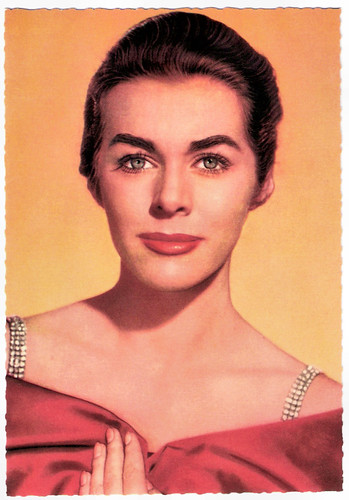
German postcard by ISV, no. G 1.
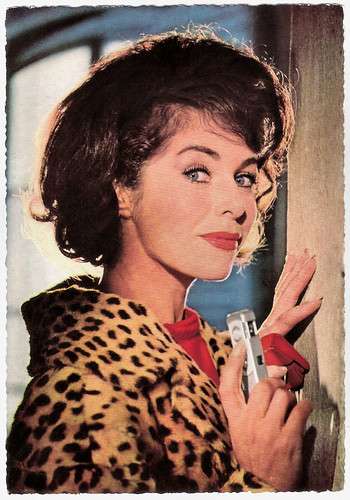
German postcard by Krüger, no. 902/187. Photo: Klaus Collignon.

German postcard by Universum-Film Aktiengesellschaft (Ufa), Berlin-Tempelhof, no. CK-36.
Best Supporting Actress of 1955
Marianne Koch was born in Munich, Germany, in 1931. She was the daughter of a businessman and a pianist. As a 10-year-old she already played theatre and she was a guest student at the opera school. In 1949 she started medical studies at the University of Munich.
As a student she made her film debut next to Rudolf Forster and Olga Tschechova in the drama Der Mann, der zweimal leben wollte/The Man Who Wanted to Live Twice (Viktor Tourjansky, 1950). The following year she made a spontaneous appearance in Dr. Holl/Affairs of Dr. Holl (Rolf Hansen, 1951) with Maria Schell and Dieter Borsche, and in Mein Freund, der Dieb/My Friend, the Thief (Helmut Weiss, 1951) with Hans Söhnker and Hardy Krüger.
She broke off her studies to become an actress full-time. She played her first leading role in the melodrama Wetterleuchten am Dachstein/Storm Clouds over Dachstein (Anton Kutter, 1953). In the American Cold War drama Night People (Nunnally Johnson, 1954) she played a supporting part alongside Gregory Peck. She stayed in Germany and appeared with O. W. Fischer in Ludwig II: Glanz und Ende eines Königs/Mad Emperor: Ludwig II (Helmut Käutner, 1955). For her portrayal of Diddo Geiss in Des Teufels General/The Devil's General (Helmut Käutner, 1955), she received the Filmband in Silber (Film Strip in Silver) for the Best Supporting Actress of 1955.
As Marianne Cook, she appeared in the Hollywood productions Four Girls in Town (Jack Sher, 1957) opposite George Nader, and Interlude (Douglas Sirk, 1957) with June Allyson and Rossano Brazzi. In Germany she played in the comedy Salzburger Geschichten/Salzburg Stories (Kurt Hoffmann, 1957) based on a book by Erich Kästner, and in the war films Der Stern von Afrika/The Star of Africa (Alfred Weidenmann, 1957) with Joachim Hansen, and Der Fuchs von Paris/The Paris Fox (Paul May, 1957) with Hardy Krüger.
In the comedy Vater sein dagegen/To Be A Father On the Contrary (Kurt Meisel, 1957) she appeared as the bride of the almost 30 years older Heinz Rühmann. She also had success as a patent country doctor in Die Landärztin vom Tegernsee/The Country Doctor of Tegernsee (Paul May, 1958). In Italy she appeared in the comedy Gli italiani sono matti/The Italians They Are Crazy (Duilio Coletti, Luis María Delgado, 1958) starring Hollywood veteran Victor McLaglen.
With Dieter Borsche. German postcard by WS-Druck, Wanne-Eickel, no. F 79. Photo: Ringpress / Vogelmann / Bavaria.

With Joachim Hansen. German postcard by Ufa/Film-Foto, Berlin-Tempelhoff, no. FK 3658. Retail price: 25 Pfg. Photo: Brünjes / Neue Emelka / Herzog Film.
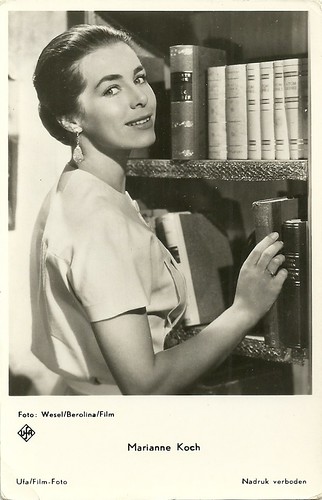
Dutch-Belgian postcard by Ufa. Photo: Wesel / Berolina Film.
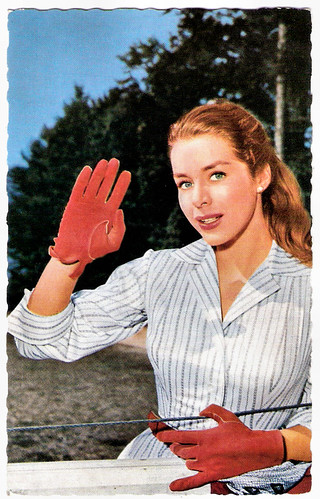
German postcard by Kolibri-Verlag, Minden/Westf., no. D 17. Photo: Constantin / Bokelberg. Publicity still for Salzburger Geschichten/Salzburg Stories (Kurt Hoffmann, 1957).
A Fistful of Dollars
In the early 1960s, the decline of the German film industry increased and Marianne Koch worked more often abroad. In France, she appeared in the thriller Pleins feux sur l'assassin/Spotlight on a Murderer (Georges Franju, 1961). It was based on a screenplay by Pierre Boileau and Thomas Narcejac on whose work film classics like Diabolique (Henri-Georges Clouzot, 1955) and Vertigo (Alfred Hitchcock, 1958) were based.
Another French production was the drama Napoléon II, l'aiglon/Napoleon II, The Eaglet (Claude Boissol, 1961) with Bernard Verley and Jean Marais. In the German-British-Irish spy thriller The Devil's Agent (John Paddy Carstairs, 1962), she appeared opposite Peter van Eyck and Christopher Lee.
In 1963 Marianne Koch played the female lead in the popular TV mini-series Tim Frazer (Hans Quest, 1963) written by Francis Durbridge.
Then, Sergio Leone's classic Spaghetti Western Per un pugno di dollari/A Fistful of Dollars (Sergio Leone, 1964) showcased her alongside Clint Eastwood as Marisol, a woman tormented by ruthless local gangsters, torn between her husband and child and the villains.
After this career highlight followed many mediocre Edgar Wallace crime films, Eurospy films and Spaghetti Westerns. One of the more interesting ones was the German-Israeli action film Einer spielt falsch/Trunk to Cairo (Menahem Golan, Raphael Nussbaum, 1966), which recycled Hollywood hero Audie Murphy as a James Bond-type action hero assigned to destroy a Neo-Nazi weapons factory headed by nemesis George Sanders.
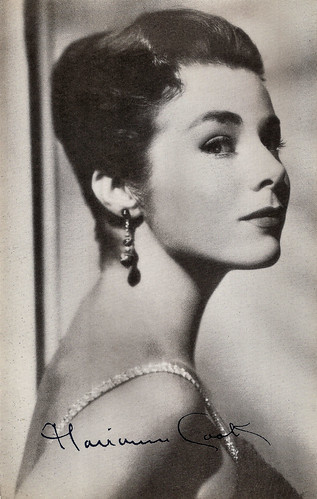
British postcard in the Celebrity Autograph Series by Celebrity Publishers Ltd., London, no. 287. Photo: Universal-International. Publicity still for Interlude (Douglas Sirk, 1957), in which she was credited as Marianne Cook.
German collectors card by Luxor.
German postcard by WS-Druck, Wanne-Eickel, no. F 10. Photo: Ringpress / Vogelmann / Bavaria.
What Am I?
In Germany, Marianne Koch was probably best loved for her many years of participation in the highly popular TV game show Was bin ich? (What Am I?) which ran from the 1950s until 1988. The show achieved ratings of up to 75% at its peak. On television, she also played a journalist in the popular TV series Die Journalistin/The Journalist (1970-1971) with Bruce Low.
By then her film career was clearly over. In 1971, she resumed her medical studies which she had broken off in 1953 to become a full-time actress. She earned her doctorate in 1978 and practised as an internist in Munich until 1997.
In the meantime, she hosted television shows and had a medical advice program on the radio. In 1976, she was one of the initial hosts of Germany's pioneering talk show 3 nach 9/Three After Nine, for which she was awarded one of the most prestigious awards of the German television industry, the Grimme Preis.
Since 1997 she has been the president of the Deutschen Schmerzliga (German Pain League). She published medical books such as 'Mein Gesundheitsbuch' (My Health Book, 1999) and 'Die Gesundheit unserer Kinder' (The Health of Our Children, 2007). In 2002, Koch was honoured for her life's work with the Bundesverdienstkreuz (Germany‘s Cross of Merit award).
In 1953, she married the physician Gerhard Freund, with whom she had two sons. The marriage ended in 1973 after Freund began an affair with Miss World 1956, Petra Schürmann, whom he later wed. Marianne Koch was in a relationship with the publicist Peter Hamm from the mid-1980s till his death in 2019. Koch lives in Tutzing, Germany.
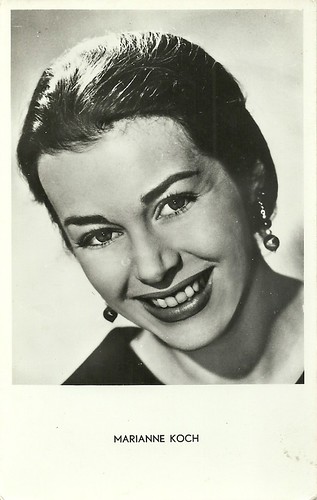
Probably a Belgian postcard.
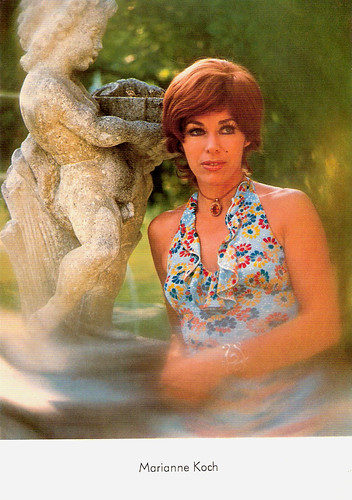
German postcard by Franz Josef Rüdel, Filmpostkartenverlag, Hamburg, no. F-72. Photo: G.M. Rozhek, München.
Marianne Koch and Heinz Rühmann sing Oh Bello in ...Vater sein dagegen sehr (1957). Source: Filmkiste (YouTube).
Sources: Stephanie d’Heil (Steffi-line - German), Wikipedia (German), and IMDb.
This post was last updated on 30 December 2024.
1 comment:
Beauty and brains! Marianne Koch is having quite a life
Post a Comment